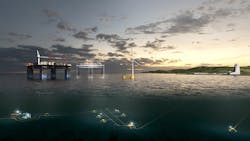Aker Solutions shifting focus to alternative energy, storage
Offshore staff
LYSAKER, Norway – Aker Solutions is looking for renewable and low carbon solutions to provide around half its revenue by 2030.
Although the oil and gas industry will likely remain the biggest market, the company is aiming for a more balanced portfolio of products and technologies, in line with global trends.
“The world will continue to see rising energy demand and the challenge for our industry is the need to deliver this with significantly lower carbon emissions,” said CEO Luis Araujo.
The transition to a lower carbon footprint will be driven by developments such as electrification, efficiency gains, low-emission fuels, and cheaper renewables. Nevertheless, the company expects demand for oil and gas to keep rising over the next decade, although not as fast as for renewable energy.
In the latter case, Aker Solutions’ growth will come mainly from floating wind. For the low carbon segment, the company will offer technologies for carbon capture, utilization and storage (CCUS), subsea gas compression, electrification of production assets and unmanned platforms.
The company has taken a 23% stake in Principle Power, which has a proven concept for floating wind and is currently installing the WindFloat Atlantic project. Aker Solutions is also involved in major wind farm developments in the US and South Korea.
It has been growing its CCUS capability since delivering the Sleipner storage solution in the Norwegian North Sea in 1996, and is presently contributing its subsea experience to the Northern Lights CO2 storage project in the same sector.
In 2015, the company delivered the world’s first subsea gas compression system to Equinor’s Åsgard field in the Norwegian Sea, and it is working on the first subsea gas compression project offshore Western Australia for Chevron’s Jansz-Io field.
Another growth area is offshore electrification, such as low emission power from shore to the Johan Sverdrup and Gina Krog fields in the North Sea.
The company is involved in several other studies.
10/23/2019
